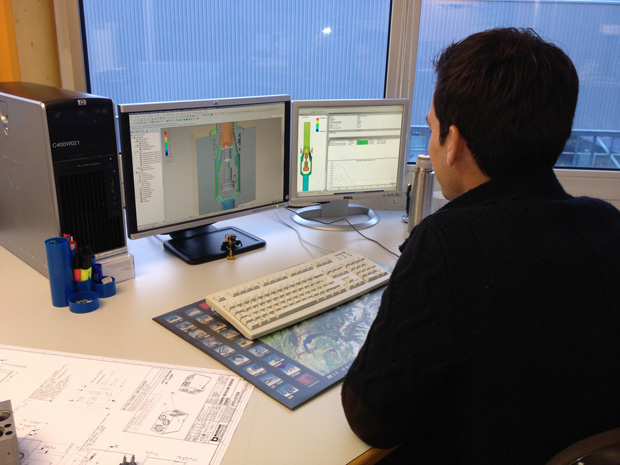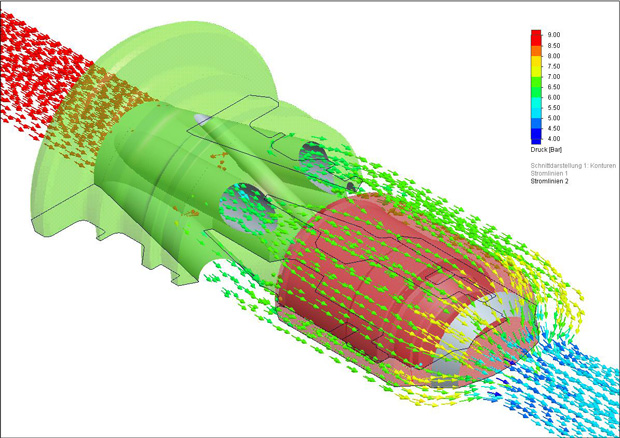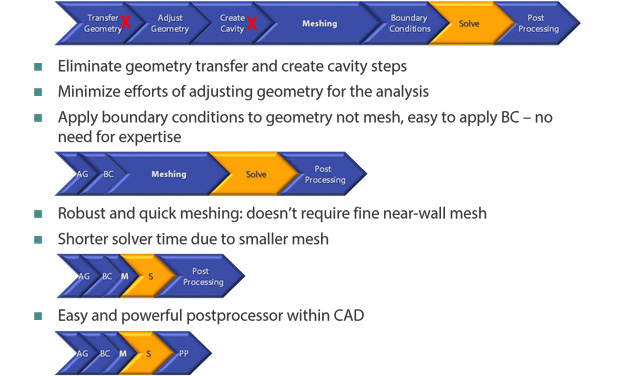
FloEFD can be used easily by design engineers within their MCAD environment. Image courtesy of Bucher Hydraulics.
Latest News
November 16, 2016
By Boris Marovic, Mentor Graphics Corporation
Leading manufacturers are abandoning the old serial design system in which various functions work along a continuum in favor of a multi-disciplinary product design process that requires successfully integrating multiple authoring systems and processes. For example, the number of electronic components in cars has grown drastically; electronics now account for 35-40% of a car’s cost, for example, the Mercedes-Benz S-Class has 140 ECUs. Designers need access to multiple tools across mechanical and electric/electronic domains to ensure a timely delivery of products that meet with customer specifications. This highly complex environment requires a high level of interdependencies to function effectively.
Despite this complexity, manufacturers that are taking advantage of simulation tools such as frontloading computational fluid dynamics (CFD) have discovered that they don’t need to reimagine or change their engineering process to benefit. While many organizations thought it would be more convenient to use existing tools, they quickly realized that they were forcing their teams to use the wrong tools. The key success factor is selecting the right solution that offers the right combination of application-specific functionality and fits into existing engineering processes without any disruption.
The new empowered engineer requires a different set of engineering tools for CFD, and these are some of the questions to ask when looking for a thermal simulation solution:
- Is the solution fully embedded into your chosen CAD system? Or does it simply offer an automated interface? The former provides a single interface between the CAD program and CFD tool so that where the CAD experience ends and CFD solutions starts is not perceptible. However, the latter uses two different interfaces with a much longer learning curve.
- Does the solution use native geometry? For frontloading CFD, native geometry removes the need for creating a second version of the design for analysis that may result in the analysis model falling out of step with the design version.
- Does the geometry have to be transferred or healed? Does the negative space representing the fluid region have to be created? If yes, this process would need to be repeated for every different variant of the model, causing wasted time and effort.
- How fast is it? For an accurate feel for speed, software has to be used in situ. Because design is an iterative process, how multiple variants are tracked also needs to be analyzed. The clock needs to start at the moment when the engineer begins the preprocessing steps to obtain an accurate measurement. Then, each step (preprocessing, solving, and post processing) needs to be separately measured for each iteration and divided into actual manual user time spent or CPU time spent for realistic measurement. Manual user time is costly and reduces the time the engineer could spend on other important things while the CPU takes over and is less expensive.
- Is it accurate? During the design stage, engineers are mostly interested in testing viability of designs, and they want to do it quickly. However, this doesn’t mean that accuracy has to be sacrificed.
- Does it have intelligent automation? Does the software offer assistance such as wizards and fully automated meshing that doesn’t require knowledge of algorithms? Does the software automatically know where the fluid regions are without any creation of extra geometry to represent it? Does the software support CAD project files so that all relevant analysis data is kept in the same area as the design? If not, time will be wasted trying to figure how to use the software and find information quickly.
- Does it help make the analyst group more effective? Frontloading CFD doesn’t replace analysis during the verification stage. Analysis simply becomes a more integral step in the design process, and routine analysis is delegated to the design engineer, allowing analysts to focus on what they do best—focus on complex flow and thermal problems and complete the final verification.
The CFD software makes it relatively easy to conduct what-if tests. Product designers can create multiple variations by modifying a solid model, which can then be analyzed without having to reapply loads, boundary conditions, and material properties, for example. The results can then be compared among the many design options to choose the best possible one.
This type of tool enables product designers to accelerate key decisions at their workstations as they experiment with design scenarios and as they hone in on the best, most efficient, reliable, and cost-effective design. This intuitive virtual prototyping process allows designers to optimize a product during the design stages, with that first physical prototype often being the design that goes into final manufacturing, delivering the best design at lower cost (because of fewer physical prototypes), and getting it to market faster than ever before.
The following is an example of how this workflow can be put to good use.
Simulation in the Hands of Design Engineers Drives Better Products
Bucher Hydraulics Division produces valves mainly used in mobile applications in construction and agricultural machinery but also in wind turbines and industrial applications such as plastic injection machines. Bucher Hydraulics AG Frutigen, located in the Bernese Oberland region of the Swiss Alps, is one of the company’s six competence centers and specializes in cartridge and customized valves and valve manifolds. Each competence center is responsible for a separate area: design/layout/construction, prototyping and testing, serial production, sales and after sales.
In the past, when Bucher Hydraulics engineers built small- and medium-sized valves, they were able to obtain test results and optimize the products in a short time at reasonable costs from their prototyping and testing competence center. They didn’t need to use flow simulation because they were able to quickly use real results.
 FloEFD can be used easily by design engineers within their MCAD environment. Image courtesy of Bucher Hydraulics.
FloEFD can be used easily by design engineers within their MCAD environment. Image courtesy of Bucher Hydraulics.But today’s projects are for valves that deliver high flow and pressure at very low pressure drop within small dimensions. For these housings or manifolds, all the CFD calculations were being done at a specialized competence center. This was causing delays because of handover from the designer to the operator (preparation of data files and explanation of the task), handover from the operator to the designer (visualization of the results and its explanation) and task misunderstandings and interpretation that would lead to several repetition loops. The team was working with four different software programs for modeling, meshing, calculation and visualization, which needed dedicated people to use and maintain daily.
They wanted simulation and testing software that would be easy to learn and easily used by the valve designer who would not be working with it all of the time. They also wanted quick and precise results with good and simple visualization, simple use of their existing 3D CAD data, and a simple data repository that would include variants.
After reviewing their options, they chose FloEFD for Creo because it enabled engineers to conduct fluid flow analysis inside the PTC Creo MCAD environment and to simulate their designs quickly, efficiently and early in the process.
They found that the layout of valves is much better, especially in regard to performance and costs, because they can analyze more variations in the amount of time it used to take to analyze a conventional design without CFD. Their first design is much closer to the target, and optimization of the prototypes is much more efficient with FloEFD. Because of the good results and availability, they use FloEFD for the design of new products in addition to optimizing existing valves.
 Analyzing versions and running through what-if scenarios is much easier and faster in FloEFD for Creo. Image courtesy of Bucher Hydraulics.
Analyzing versions and running through what-if scenarios is much easier and faster in FloEFD for Creo. Image courtesy of Bucher Hydraulics.Time is of the essence in today’s global marketplace, and by enabling design engineers at Bucher to conduct what-if analysis and progress their designs quickly, the company is able to provide products that offer a great combination of functionality and high reliability with a great price performance ratio.
More Info
Subscribe to our FREE magazine, FREE email newsletters or both!
Latest News







